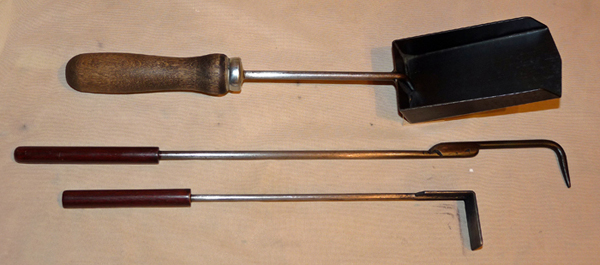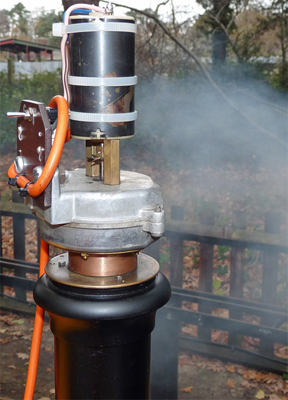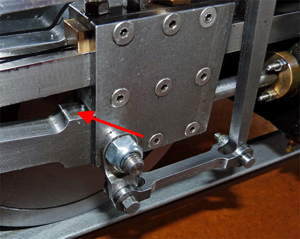 |
 |
 |
Firing Up
| Keeping
the fire burning properly in the firebox of a steam engine is the
second most important thing that the operator of the engine has to do
(with the most important being to operate the engine safely).
The Stafford saddle tank locomotive uses a type of
boiler called a "Marine
Boiler" which results in it having a relatively shallow depth to it's
fire. If
you understand the significance of having this type of boiler and are
happy with your choice of coal then please read
on, but if not it may be worthwhile clicking
here to learn more. As regards safety, if you are running as a club member at your club track to should be covered by the clubs insurance. However if you wish to run away from you home club you should probably consider having at least Third Party Insurance in case of any accidents, I have always obtained such insurance for my traction engines and locomotives from Walker Midgley Insurance Brokers (see the links page for details). |
 Before
you can start to light the fire in your Stafford you will need a set of
Firing Irons, and to be independent of any particular running site an
electric steam raising blower. You may quickly develop your
own preference for the sizes of firing irons, but my choice has evolved
to the following: Before
you can start to light the fire in your Stafford you will need a set of
Firing Irons, and to be independent of any particular running site an
electric steam raising blower. You may quickly develop your
own preference for the sizes of firing irons, but my choice has evolved
to the following:A shovel (110mm long, by 55mm wide, and 30mm deep) with a 210mm long handle. A rake, with the 6mm diameter "point" welded to the shaft to allow for easy replacement. A scraper, used only when the loco is being cleaned. Since the shovel and rake are used in the firebox when the fire is alight (and can occasionally come out glowing red hot) they are of all welded construction, while the scraper is simply silver soldered as it never gets hot. By making the firing irons myself I have the advantage of a set of tools custom designed for the task, but you can purchase similar items from model engineering suppliers. |
 The next item you will require,
or at least have access to at the track, is a steam raising
blower. Steam
raising blowers come in all shapes and sizes, but if you want to read
about them and find out about my "customised" blower (shown working on
my Stafford in the photo) then please click
here. The next item you will require,
or at least have access to at the track, is a steam raising
blower. Steam
raising blowers come in all shapes and sizes, but if you want to read
about them and find out about my "customised" blower (shown working on
my Stafford in the photo) then please click
here.Next you will require some oils, and Station Road Steam recommend (as detailed in the owner's manual supplied with the Stafford) SAE 220 for general lubrication and Compound Steam Oil SAE 680T for the mechanical lubricator that adds oil to the steam before it enters the cylinders. Both are available from Morris Lubricants and may be purchased "on line" via the Internet. A small bottle of boiler water treatment is supplied with each Stafford, and the dosage is so small that I predict it will last me for about 200 miles of running. The purpose of this water treatment is to reduce the oxygen levels in the boiler water because oxygen is required for steel to rust. As the Stafford's have a steel boiler the use of water treatment should help prevent the steel from rusting and prolong the life of the steel boiler. Finally the last thing you need to acquire before you light the fire in your Stafford is some form of fire lighter. You could buy fire lighters from your local hardware store, or use paraffin soaked sticks of wood, but Station Road Steam recommend using charcoal soaked in paraffin and I have stuck with this as it has never failed me so far. The best charcoal I have found to date was lumpwood charcoal from a small charcoal kiln at a local rural life centre. It was very light in weight, easy to break into suitably sized lumps (about 1/2 the size of a normal hens egg) and it soaked up paraffin easily. I have also used lumpwood charcoal from my local DIY store, but that is heavier, much harder to break, and burns with a lot of sparks. If you put the charcoal in a sealed container full of paraffin for about a week, and then drain off the paraffin the charcoal will ignite and burn very easily. With everything ready to run the Stafford there are a few checks to be made before you are ready to light the fire, and if you are unsure of the location of all the controls you can view the website page about the controls by clicking here. Ensure that the loco's hand brake is "on" so that the loco will not roll away. Check that the smokebox door at the front of the boiler is firmly screwed shut and that the two firebox cover plate thumbscrews are tight, as if either are loose air will leak in and make the boiler less efficient. Check that the saddle tank drain cock (in the centre of the copper balance pipe below the boiler) is closed. From experience I would suggest taking care with this check as the drain cock appears to work in the wrong direction. You "screw it in" to open it and "screw it out" to close it; but if you wind it the wrong way when you think you are closing it, you will (with no effort at all) force the operating arm off the shaft and need to fit a new drain cock. Take care with this check ! Make sure that the regulator (throttle) is shut e.g. in its most clockwise position, and that the reversing lever is in its central position. You would probably be surprised to know how many people have failed to do these checks and seen their locos set off down the track without them as the steam pressure starts to rise. Open the steam valves for the two injectors to allow air to escape from the boiler when you fill it with water, but close the steam valves for the blower (and if fitted vacuum brake ejector). All of the steam valves only need to be closed gently as over tightening may damage the valve seat and subsequently allow steam to leak past the valve. If you look at the photo below showing the fire being lit you will see that the sight glass which shows the boiler water level has three cocks (taps) on it. Their use is fully described on the controls page of this website, but you should check that they can be opened and then ensure that they are in the positons shown before you start to fire up your Stafford. The photo shows the three cocks with their levers in the correct positions for normal operation. Finally, open the cylinder drain cocks (if they are not already open) and check that the two injector water valves are closed. Now we are ready to fill the boiler with water. |
 The
Stafford's boiler is filled with water using a hose connected to the
blowdown valve underneath the firebox (the centre section of the
footplate lifts out to improve access to the valve) and with the loco
on a level section of track you will need to fill the boiler until the
water level is half way up the sight glass. Once the fire is
lit and the boiler heats up you will find that you end up with a nearly
full boiler and the water level will be close to the top of the sight
glass. With the boiler filled, close the blowdown valve and
shut the two injector steam valves. Next fill the saddle tank
with water and add the water treatment. Using the bottle
supplied with the Stafford the normal amount is about 20 drops
to treat a full tank of water. The
Stafford's boiler is filled with water using a hose connected to the
blowdown valve underneath the firebox (the centre section of the
footplate lifts out to improve access to the valve) and with the loco
on a level section of track you will need to fill the boiler until the
water level is half way up the sight glass. Once the fire is
lit and the boiler heats up you will find that you end up with a nearly
full boiler and the water level will be close to the top of the sight
glass. With the boiler filled, close the blowdown valve and
shut the two injector steam valves. Next fill the saddle tank
with water and add the water treatment. Using the bottle
supplied with the Stafford the normal amount is about 20 drops
to treat a full tank of water.The subject of water for model boilers always raises a lot of discussion among modellers because hard water results in lime scale building up inside the boiler. When operating my traction engine I used a water treatment system at home to remove the calcium from the water and fill two 25 litre containers that would allow me to run the traction engine for a day on nice soft water. Unfortunately when using the Stafford to pull passenger trains all day so much water is needed that I have to make do with whatever water is available "on site". Back with the Stafford we are at last ready to light the fire. First, cover the grate with a layer of the paraffin soaked charcoal. Put a couple of pieces on your shovel, light them with a match, and then put them in the firebox and switch on your steam raising blower. With the firebox door closed wait a couple of minutes for the fire to spread to the rest of the charcoal and then add a shovel full of coal evenly distributed across the grate. Shut the firebox door again, wait another couple of minutes and then add some more coal. The aim is to gradually increase the coal on the fire so that it has time to ignite. If you throw in too much coal too soon you will smother the fire and probably put it out, so just take it easy and keep opening the firebox door to see how things are progressing. Once the fire is burning nicely the aim is to keep the coal built up to a level just above the bottom of the fire hole door, ensuring that the coal is level across the whole area of the grate. If all goes well it should take about 45 minutes from lighting the fire to reach operating pressure, so now is the time to lubricate the loco ready for running (but don't forget to keep adding coal to the fire). Fill the mechanical lubricator with steam oil and give the operating handle a couple of turns to pump some oil into the steam pipe ready for starting the loco. Then go right round the loco and oil all the moving parts. Many parts, such as the connecting rods, have oil holes to be filled while other parts just need a drop of oil on the moving joints. Don't forget the brake and drain cock mechanisms that will also benefit from being oiled. Don't be alarmed if while you are firing up water occasionally drips from the injector overflows. Until the boiler is at a reasonable pressure there is nothing to hold the clack valve balls onto their seats so water may leak past. When you finally have boiler pressure you will be testing the injectors (see later on this page), and after that the drips should cease. |
 The
Stafford also has one oil point that is very easy to miss, in fact it
took me a few runs to actually spot it ! The photo
here
shows the crosshead assembly that guides the piston rod and contains
the "little end" bearing of the connecting rod. The easily
missed
oil sump is shown by the red arrow. Stafford's built in the
later
batches also have oil sumps built into the piston and valve rod glands,
but if you own an early Stafford like me you need to oil the piston and
valve rods at the glands. The
Stafford also has one oil point that is very easy to miss, in fact it
took me a few runs to actually spot it ! The photo
here
shows the crosshead assembly that guides the piston rod and contains
the "little end" bearing of the connecting rod. The easily
missed
oil sump is shown by the red arrow. Stafford's built in the
later
batches also have oil sumps built into the piston and valve rod glands,
but if you own an early Stafford like me you need to oil the piston and
valve rods at the glands.Hopefully by the time you have "oiled up" (and had a cup of tea) the boiler pressure will be starting to rise, so it's just a case of continuing to add coal until the boiler pressure reaches about 45 psi. Then you can switch off the steam raising blower and remove it because the loco's own steam blower can take over. A word of warning here; when the steam blower is first turned on you may get a shower of water blowing out of the funnel for a couple of seconds so it is best to warn people not to stand too close to the funnel when you first use the steam blower. The blower steam valve just needs to be opened a little to get a good "hiss" up the funnel, if you get a full blooded "roar" you have opened the valve too far. Continue to use the steam blower until the boiler pressure reaches about 90 psi and then almost close the steam blower valve. Practice will make perfect, but the aim is to use just enough blower while the loco is stationary to keep the fire burning nicely. Too much blower will produce excess steam which will just be wasted when the safety valve opens. Another word of caution here, this time for the safety valve. The first time I allowed the safety valve to open, during an initial test to prove to my Club's chief engineer that it would work correctly, it opened instantaneously and with a roar like a volcano soaked everyone in the vicinity with hot water. As the months have gone by the safety valve seems to have tamed down a bit and now opens more gently, but it is worth bearing in mind that it is designed to snap open and may scare young children in the vicinity. With the boiler pressure at about 90 psi it's a good time to check that the injectors work, and if fitted the vacuum brake ejector (the operation of the injectors and ejector are described on the controls page of this website). The Stafford's are fitted with two injectors, and these are the only way of getting water into the boiler when operating the loco, so always check their operation before setting off on the track. The final check is to prove that the loco is able to move, and then you will be ready to run on the track. First make sure that the regulator is still fully closed (all the way to the right) and that nothing is in the way of the loco when it moves. Make sure that the cylinder drain cocks are open (the lever on the footplate is fully forward) and then move the reversing lever fully forward. Release the loco's brake, and as you very gently open the regulator (turning the operating handle towards the left) the loco should start to move forwards with steam, water (steam that has condensed in the cold cylinders), and oil from storage, hissing out of the cylinder drain cocks. Shut the regulator, move the reversing lever fully back, and gently open the regulator to confirm that the loco will reverse. Close the regulator, centralise the reversing lever, apply the brake, and then check the coal and water levels for a final time before you head out onto the track. All you need to do is hitch up your driving truck (wagon, trolley or whatever) to carry you, together with a supply of coal plus your shovel and rake. You may also like to keep both the lubricating and steam oils together with the water treatment on the truck, but I tend to leave that lot with my spare coal supply in the station area of my home track. |